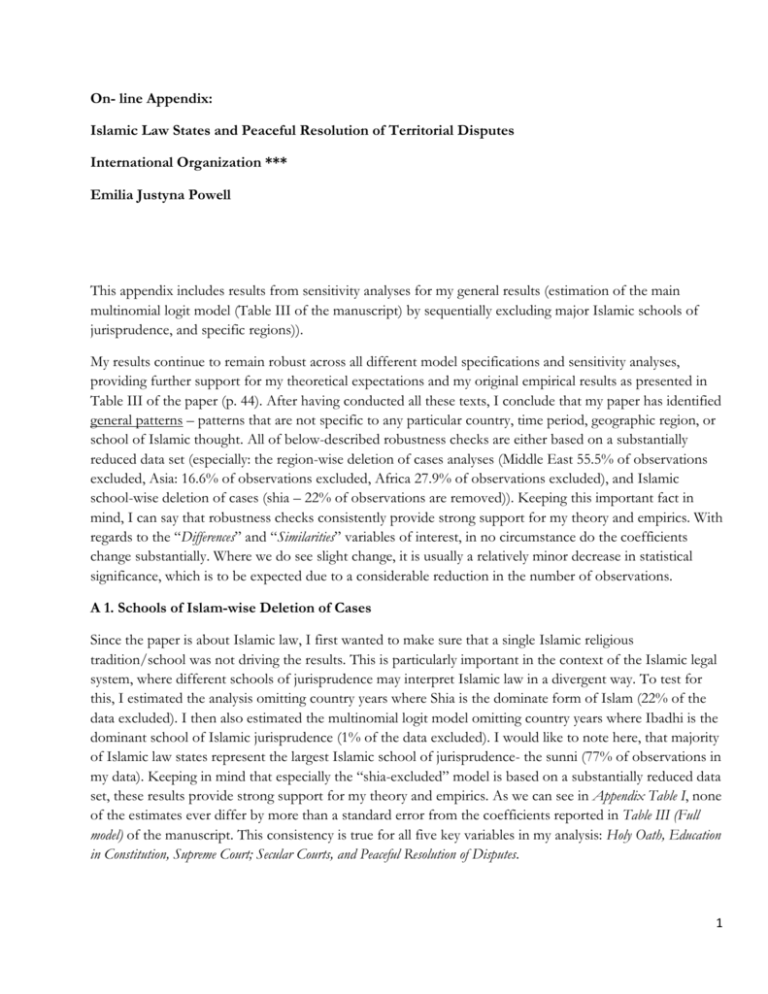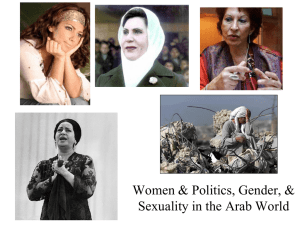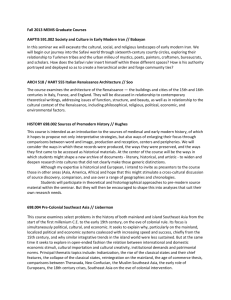Online Appendix
advertisement

On- line Appendix: Islamic Law States and Peaceful Resolution of Territorial Disputes International Organization *** Emilia Justyna Powell This appendix includes results from sensitivity analyses for my general results (estimation of the main multinomial logit model (Table III of the manuscript) by sequentially excluding major Islamic schools of jurisprudence, and specific regions)). My results continue to remain robust across all different model specifications and sensitivity analyses, providing further support for my theoretical expectations and my original empirical results as presented in Table III of the paper (p. 44). After having conducted all these texts, I conclude that my paper has identified general patterns – patterns that are not specific to any particular country, time period, geographic region, or school of Islamic thought. All of below-described robustness checks are either based on a substantially reduced data set (especially: the region-wise deletion of cases analyses (Middle East 55.5% of observations excluded, Asia: 16.6% of observations excluded, Africa 27.9% of observations excluded), and Islamic school-wise deletion of cases (shia – 22% of observations are removed)). Keeping this important fact in mind, I can say that robustness checks consistently provide strong support for my theory and empirics. With regards to the “Differences” and “Similarities” variables of interest, in no circumstance do the coefficients change substantially. Where we do see slight change, it is usually a relatively minor decrease in statistical significance, which is to be expected due to a considerable reduction in the number of observations. A 1. Schools of Islam-wise Deletion of Cases Since the paper is about Islamic law, I first wanted to make sure that a single Islamic religious tradition/school was not driving the results. This is particularly important in the context of the Islamic legal system, where different schools of jurisprudence may interpret Islamic law in a divergent way. To test for this, I estimated the analysis omitting country years where Shia is the dominate form of Islam (22% of the data excluded). I then also estimated the multinomial logit model omitting country years where Ibadhi is the dominant school of Islamic jurisprudence (1% of the data excluded). I would like to note here, that majority of Islamic law states represent the largest Islamic school of jurisprudence- the sunni (77% of observations in my data). Keeping in mind that especially the “shia-excluded” model is based on a substantially reduced data set, these results provide strong support for my theory and empirics. As we can see in Appendix Table I, none of the estimates ever differ by more than a standard error from the coefficients reported in Table III (Full model) of the manuscript. This consistency is true for all five key variables in my analysis: Holy Oath, Education in Constitution, Supreme Court; Secular Courts, and Peaceful Resolution of Disputes. 1 There are very few cases of slight loss of statistical significance, which is to be expected due to a considerable reduction in the number of observation (for example Holy Oath in the first model (shia excluded). Importantly, however, the Holy Oath variable missed statistical significance by a sheer margin P>|z|=0.14. This variable also remains statistically significant in the ibadhi-excluded analyses. In cases, where we see a change in the direction of the relationship, the variables are not only statistically insignificant, but also associated with large P>|z|values, such as with Secular Court variables in the shia-excluded model, in the context of comparing the nonbinding methods with the binding methods (P>|z| =.959). In general, based on these additional sensitivity analyses, I can identify no particular school of Islamic jurisprudence that drives the results. Even a substantial reduction of observations associated with the exclusion of the shia school, does not cause my results to change. A 2. Region-Wise Deletion of Cases. Appendix Table II. Distribution of Regions in the Dataset Region Middle East Asia and Oceania Africa Entire Dataset Frequency Percentage 264 79 133 55.5% 16.6% 27.9% Dataset without Outliers: Iraq 1958-1984; Bahrain 1986-1998 Frequency 245 79 133 Percentage 53.6% 17.3% 29.10% As the above Table demonstrates, observations in my data are from three regions: the Middle East (55.5% of observations), Asia and Oceania (16.6% of observations), and Africa (27.9% of observations). Thus, results from the Full Model (Table III, p. 44 of the paper) present general trends that apply not only to a specific region, but illustrate dynamics at works in cases spanning three geographical areas. The same can be said of the dataset that I used to estimate the Model Without Outliers (Table III, p. 44 of the paper). Removing Iraq 1958-1984 and Bahrain 1986-1998 caused the data to be spread slightly more evenly among the three regions. I also wanted to determine whether a single region is the locus of the relationships observed in my analysis, so I conducted the analysis omitting a region each time. This test is a high hurdle to cross since a substantial portion of the observations are omitted in each test (16.6% for Asia; 27.9% for Africa, and 55.5% for the Middle East). Appendix Table III presents these results. By and large the results are remarkably robust. Instances of coefficients deviated from the estimates in my manuscript (Table III, Full Model) by more than a 2 standard error are very rare. However, since most instances of the coefficient deviations take place when I exclude the African region from the analysis (27.9% of observations), I would like to comment briefly on why this may be the case. The African Islamic law states included in my data are: Mauritania, Nigeria, Comoros, Morocco, Tunisia, Libya, Sudan, and Egypt. Attempts at peaceful resolution made by these states range from 2 (Sudan) to 31 (Egypt). Removing African cases from the analysis has, in comparison with the other regions, the most substantial impact on the results, which is to be expected since domestic laws (formal and informal) of African Islamic law states exemplify my arguments particularly well. In majority of these countries, the informal dispute resolution constitutes a strong and long-standing tradition within families, tribes, and larger social communities. This is true for traditional Islamic law states as well as countries where the official commitment to Islamic law is perhaps less comprehensive (Tunisia, Morocco). As discussed in the paper, even in these states, sharia and informal third-party procedures are incorporated in familial and other types of civil disputes. Interestingly, six out of eight African states are placed in the nonbinding third-party methods group in Table V of the manuscript, which further illustrates patterns discovered in the context of “Africa-excluded” analysis. 3 Appendix Table I: Islamic Schools of Jurisprudence Excluding Shia (22% of observations excluded) Excluding Ibadhi (1% of observations excluded) Negotiations Nonbinding ThirdParty Methods Negotiations Nonbinding ThirdParty Methods Sharia-based Education -.22(.90) .47(.72) .14(.86) .06(1.1) Holy Oath 1.9(1.3) .83(.93) 1.5(.61)** 1.1(.62)* Sharia/Islam .003(.01) .02(.01) .004(.004) -.001(.003) Women in Courts -1.2(.73)* -.45(.98) -.65(.49) -.11(.44) Education in Constitution Supreme Court -1.1(.89) .72(.78) -.61(.80) .68(.82) -.60(.62) -.95(.39)** -1.1(.57)* -1.2(.56)** Secular Courts -.65(.54) .05(.99) -1.08(.63)* -.56(.84) Peaceful Resolution of Disputes -1.4(1.5) -4.8(1.6)*** -1.8(1.6) -4.09(1.4)*** Treaty Commitments -.60(.2)** -.06(.20) -.57(.18)*** -.04(.16) Ethnic Value 1.3(1.4) 2.0(1.3) 1.8(1.3) 2.1(1.09)** Economic Value .97(.99) 1.11(1.4) 1.9(1.04)* 1.28(1.2) Strategic Value -1.3(1.4) .05(1.13) -.06(.79) .28(.37) Capabilities 3.4(2.9) 3.7(3.5) 6.7(2.8)** 5.03(2.7)* Democratic Dyad -.85(.59) .21(.7) -.74(.67) .30(.75) Past Fight -.07(.52) .78(.50)* .11(.39) .94(.43)** Constant 1.2(3.7) -3.7(4.3) -2.53(3.3) -4.4(3.0) Differences Similarities Controls N 321 402 Pseudo R2 .234 .233 Log pseudolikelihood -237.44 -296.92141 Notes: Clustered standard errors in parentheses; *p<.10, **p<.05, ***p<.01; Binding third-party methods is the base outcome 4 Appendix Table III: Geographic Regions. Excluding Middle East (55.5% of observations excluded) Negotiations Excluding Asia/Oceania (16.6% of cases excluded) Excluding Africa (27.9% cases excluded) Nonb. Third- Negotiations Party Methods Nonb. ThirdParty Methods Negotiations Nonb. ThirdParty Methods Sharia-based Educ. -1.52(1.3) 1.07(1.4) -.06(.88) .32(.88) .21(2.1) -2.6(1.2)** Holy Oath .52(1.8) -1.1(1.6) 2.11(.74)** 1.3(.75)* .58(.90) .18(.75) Sharia/Islam .04(.02)* .07(.01)*** .007(.004) -.005(.004) .002(.004) -.004(.005) Women in Courts -2.5(1.3)* -3.3(1.1)** -.24(.62) -.15(.52) -.08(.74) 1.2(.56)** Educ.in Const. 1.8 (.93) 4.7(1.6)** -1.25(.86) .31(.80) -3.2(1.01)** -1.6(1.3) Supreme Court -.84(1.4) -1.4(1.2) -1.1(.56)** -1.2(.64)** .30(.94) .28(.78) Secular Courts -16.8(2.08)** -20.1(2.02)*** -1.6(.74)** -.11(1.00) .18(.52) -.64(.75) PRD -7.8(2.7)** -11.1(2.88)*** -2.7(2.6) -25.5(1.8)*** -16.04(1.1)*** -19.6(1.3)*** Treaty Com. -.17(.43) .30(.53) -.54(.21)** .06(.16) -.06(.27) .40(.29) Ethnic Value .78(1.9) .33(2.1) 1.6(1.2) 1.3(1.00) 15.3(.80)*** 15.5(.54)*** Economic Value 3.1***(.82) 4.4(1.4)* 1.5(1.1) 1.4(1.3) .29(.76) 1.2(1.03) Strategic Value -2.4(1.5) -1.25(1.01) .17(.86) .14(.45) 1.3(1.1) 1.6(.81)* Capabilities 7.9(5.8) 8.4(5.5) 7.01(2.9)** 5.5(2.7)** 4.5(1.7)** 4.2(1.1)*** Democratic Dyad -.39(.79) .455(.75) -2.8(1.2)** -14.4(1.7)*** -.8(.23)*** 1.9(.98)* Past Fight 1.06(.65)* 2.00(1.01)** -.17(.52) .69(.57) .76(.61) 1.2(.48)** Constant 12.69(5.5)** 11.2(5.6)** -1.9(3.4) -5.2(3.3) -.96(2.4) -4.1(1.9)** Differences Similarities Controls N 186 358 322 Pseudo R2 .295 .25 .30 Log pseudolike. -136.669 -250.64 -217.5 Notes: Clustered standard errors in parentheses; *p<.10, **p<.05, ***p<.01; Binding third-party methods is the base outcome. 5









